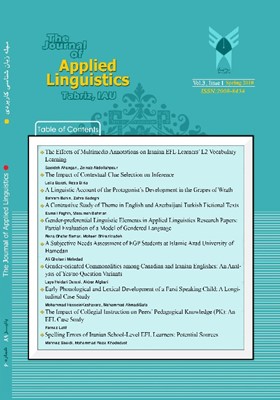A Contrastive Study of Theme in English and Azerbaijani Turkish Fictional Texts
الموضوعات : آموزش زبان انگلیسیاسماعیل فقیه 1 , معصومه بهمن 2
1 - South Tehran Branch, Islamic Azad University, Tehran, Iran
2 - Tehran University of Medical Sciences
الکلمات المفتاحية: rheme, experiential, interpersonal and textual theme,
ملخص المقالة :
Thematisationis one of the troublesome areas both for translation purposes from or into English and also for learning EFL. The main reason for the problem lies in the fact that usually different languages structure thematisation in different ways. Therefore, the present research is an attempt to investigate contrastively: experiential (topical), interpersonal and textual themes in a sample of Azeri Turkish and English short stories. Specifically, it aims to find out whether these three kinds of themes have similar occurrences in these two languages or not. To characterize thematising in fictional texts on an empirical basis the model of analyzing theme as suggested by Halliday (2002) is applied to a small corpus of two short stories. The study revealed that in both English and Azeri Turkish, experiential, textual and interpersonal themes are used more frequently in this order respectively. It is hoped that the results of this study can contribute to both theoretical and applied linguistics.
Ahmadi Givee, H. (2005). Dastoor-e-Tatbighee ye Zabane Turkiva Farsi (Comprative Grammar of Turkish & Farsi Languages). Tehran: Ghatre.
Behzadi, B. (2003). Farhange Azerbaijani-Farsi (Azerbaijani Persian Dictionary). Tehran: Farhang Moaser.
Behzadi, B. (2007). Dastoor-e-Zaban-e-Azerbaijani (Grammar of Azerbaijani). Special Issue of Azeri, 16 & 17, Summer & Fall. 1386.
Brown, G. & Yule, G. (1983).Discourse Analysis. Cambridge: Cambridge University Press.
Downing, A. (2001). Thematic Progression as a Functional Resource in Analyzing Text. Retrieved December 8, 2007 , from http://www.ucm.es/info/circulo/no%/downing.htm
Faghih, E. (1997). A Contrastive Analysis of the Persian & English Definite Articles. IRAL. XXXV/2May.
Fischer, M. (1980).Iran: From Religious Dispute to Revolution. Cambridge: Mass: Harvard University Press.
Faulkner, W. That Evening Sun. In Perrine, L. Literature Structure, Sound, & Sense. (1995). New York: Harcourt Brace Javanovich.
Halliday, M.A.K. (1985). An Introduction to Functional Grammar. London: Arnold.
Halliday, M.A.K. (2002). Linguistic Studies of Text & Discourse. J. Webster (Ed.). (Vol.2).London: Continum.
Heyat, J. (2000). SayreedarTarikhZabanvaLahjehayeTurki (A Survey of the History of Turkish Languages & Dialects). Tehran: Paykan Publishers.
Hasselgard, H. (2000, 02,14,17). More on Word Order & Thematic Structure. [lecture]. Retrieved December 5, 2007, from :http://folk.uio.no/hhasselg/systemic/textual.htm
Lassen, I. (2004).Ideational Resources in Biotechnology Press Release: Pattern of Theme / Rheme & Given/New. In L. Young & C. Harrison (Eds.).Systematic Functional Linguistics & Critical Discourse Analysis: Studies in Social Change (pp.264-279). London: Continuum.
Marefat, H., & Tahririan, M.H. (2001). Information Structure in Persian. Iranian Journal of Humanities, 8 (2), 25-30.
McCarthy, M. (1991).Discourse Analysis for Language Teachers. Cambridge: Cambridge University Press.
Richards, J.C., Platt, J.,& Platt, H. (1992).Dictionary of Language Teaching & Applied linguistics. London: Longman.
Sabahi, G. Arsiz Ghaffar(The Shameless Ghaffar). In M. Sobhdel, & F. Mirhasanpour (Eds.).(2004). Azerbaijan Hekayalari (The Collection of Azerbaijanian Short Stories) (Vol.1)(pp.47-64).Urumiah :Yaz Publications.
Shokouhi, H., & Kamyab, Gh. (2004). Analysing Discourse: Multivariant Perspectives. Ahvaz: Shahid Chamran University Press.
Stillar, G.F. (1998).Analyzing Every day Texts: Discourse, Rhetoric, & Social Perspectives. California: Sage Publications.
Widdowson, H.G. (1975). Linguistic Insights & Language Teaching Principles. In C.Gutknecht (Ed.): From Linguisticum, (Vol.III)Communicative Linguistics(pp. 1-28).Language, Geneva.
Wikipedia The Free Encyclopedia. Azerbaijani Language.Retrived November 5,2010, from : http://en.wikipedia.org/ wiki/Azerbaijani_language
Yarmohammadi, L. (1995). Textual Analysis of English & Persian Written Texts in contrast & Its Possible Pedagogical Implications.In L. Yarmohammadi (Ed.), Fifteen Articles in Contrastive Linguistics & the Structure of Persian : Grammar, Text & Discourse (pp. 101-123). Tehran: Rahnama Publication.
Zehtabi, M.T. (2005). Azerbaijan TurkjasininNahvi (Syntax of Azeri Turkish). Tabriz: Akhtar.


